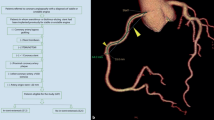Summary
At present the rate of restenosis after PTCA and stent implantation is approximately 30% in clinical routine practice. The aim of the present study was to investigate the influence of regional disturbances of left ventricular contractility, e.g. due to scars, on the development of restenosis after PTCA and stent implantation. In 310 patients with single stent implantation in the LAD, quantitative coronary angiography and ventricular analysis with the centerline wall motion model (Cardiovascular measurement systems, Medis, The Netherlands) were performed before, immediately after stent implantation and at angiographic follow-up after 3 to 6 months. Thirty-nine percent of all patients (121 patients) showed regional dysfunction of the left ventricular anterior wall. Increase of percent stenosis (relative late lumen loss) between stent implantation and follow-up angiography showed no correlation to left ventricular wall motion abnormalities (r=0.243). There was no significant difference in restenosis rates between patients with or without left ventricular wall motion abnormalities (28.9% vs. 30.7%, p=0.74). In conclusion, this study provides evidence that kinetic disorders of the left ventricular wall have no significant influence on long-term results after PTCA and stent implantation.
Zusammenfassung
Die Restenoserate nach PTCA und Stent-Implantation liegt im klinischen Durchschnitt bei ca. 30%. Das Ziel der vorliegenden Untersuchung war es, den Einfluss einer linksventrikulären regionalen Kinetikstörung auf die Entwicklung der Restenose nach Stentimplantation zu untersuchen. Bei 310 Patienten, die mittels PTCA und Implantation eines einzelnen Stents in der LAD behandelt worden waren, wurde eine quantitative Analyse der Koronarangiographie (QCA) und der linksventrikulären Angiographie (QLVA, Centerline Wall Motion Modell) mit dem Cardiovascular Measurement System der Firma MEDIS durchgeführt. 39% (121 Patienten) zeigten eine Kontraktionsstörung der linksventrikulären Vorderwand bei diagnostischer Angiographie. Der relative Lumenverlust zwischen dem Zeitpunkt der Stentimplantation und dem angiographischen Follow-up (definiert als Zunahme des prozentualen Stenosegrades) zeigte keine Korrelation zur Einschränkung der linksventrikulären Funktion, quantifiziert durch die bei der QLVA definierte Fläche als Maß der Kinetikstörung (r=0,243). Auch die Restenoseraten der Patienten mit und ohne Kontraktionsstörung der Vorderwand zeigten keinen signifikanten Unterschied (28,9% vs. 30,7%, p=0,74). Die regionale Kontraktilität des linken Ventrikels im gefäßabhängigen Versorgungsgebiet scheint daher keinen Einfluss auf die Restenoseentwicklung nach PTCA und Implantation eines Stents zu haben.
Similar content being viewed by others
Author information
Authors and Affiliations
Additional information
Eingegangen: 15. Januar 2001 Akzeptiert: 12. April 2001
Rights and permissions
About this article
Cite this article
Sick, P., Grieshammer, S. & Schuler, G. Restenoserate nach koronarer Stentimplantation in Abhängigkeit von der regionalen linksventrikulären Funktion. Z Kardiol 90, 745–750 (2001). https://doi.org/10.1007/s003920170094
Issue Date:
DOI: https://doi.org/10.1007/s003920170094




